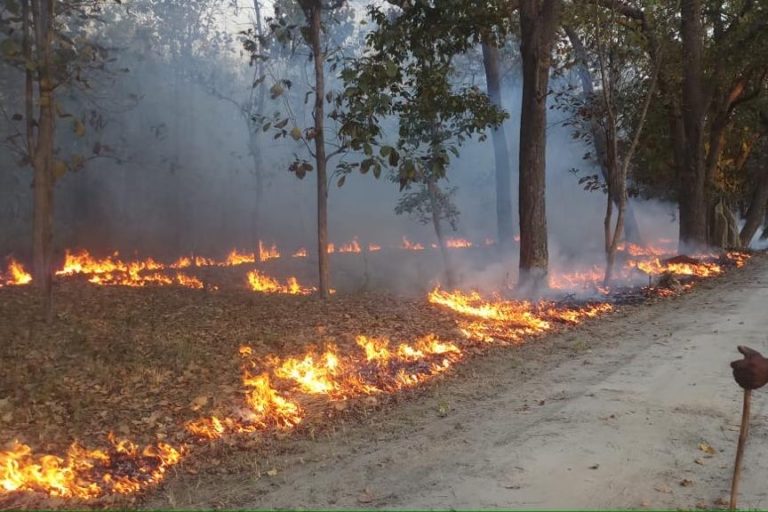- India is home to different kinds of forests, each of which respond to fire differently, writes Bharath Sundaram from Krea University.
- The idea that all fires are destructive is part of a colonial mindset inherited from the British.
- In this commentary, Sundaram recommends working with indigenous communities for forest management.
A recent article in Mongabay-India about how to deal with forest fires in India argues that fire suppression should be replaced by fire prevention with the help of local communities. These recommendations are overly simplistic and misleading for three reasons.
The first, is similar to the ‘Africa is a country’ fallacy perpetuated elsewhere. There are several forest types in India that are prone to fires. None of them respond in uniform ways to fire. The second, is that the article continues to wrongly promote a colonial mindset of viewing all fires as detrimental and destructive. Third, the article continues a troubling tendency to refer to forest-dwellers in the third person, and ignoring easily-accessible, first-person accounts describing the role played by forest fires in their ecological and cultural landscapes.
The Indian subcontinent has a wide variety of forest types owing to unique biogeographical and topography. The effects of fires on forests depend entirely on what kind of a forest it is. Does the fire occur in an evergreen rainforest, a semi-evergreen coniferous forest, an oak woodland, a grassland savannah, a moist deciduous forest or a scrub forest? The answer to this question is important because the effects of fire dramatically varies in each of these types.
Evergreen forests, which have not been exposed over evolutionary time to fire, cannot withstand even low-intensity fire. On the other hand, dry deciduous forests and grassland savannas have been shaped by fire over millions of years, with a clear fire regime. The Indian subcontinent has a wide variety of forest types owing to unique biogeographical and topographical variation.
The complexity does not stop there. Even within deciduous forests, there are many sub-types that are distinct geographically and culturally. The sub-Himalayan chir pine forests (pine plantations were considered more of more value economically compared to oak) are more fire prone than the oak forests present in the same area. Riparian moist deciduous forests in the Western Ghats are less fire prone (and possibly more sensitive to fire-effects) than the dry deciduous forests just a few hundred meters away, where trees with thick bark and the capacity to re-sprout from rootstock can withstand fire.

The iconic Shola-grassland system is maintained by frost and fire, with frost creating tree stunting and grass die-back, and fire preventing ingress of the vegetation when occurring on the grassland. Even within each of these sub-types, the effect of fire depends on timing, intensity, and frequency.
Africa is not a country, and Indian forests are not all the same when it comes to how they respond when burned.
In a lot of ways, the view that all fires are bad, irrespective of which forest they occur in, is an inheritance from colonial forest management. During the time when the East India Company was morphing into the British Crown, monetising the subcontinent’s forested areas was high up on the agenda, considering that almost half the landmass was forested in some way or the other. It was no surprise that officers of the Imperial Forest Service, the bulk of whom had little exposure to forests of these kinds before, viewed forest fires as destructive, as something to be banned in order to prevent the burning up of precious timber ‘stock.’
The banning of forest fires, and making the setting fire an offence, had severe social repercussions as well. Forest people, some of whom were agriculturalists, found themselves getting the short end of the stick while pursuing their livelihood. The use of fire to clear paths or the underbrush to enable movement through forests was also banned. Clearing leaf litter to collect chital antlers or mahua flower-buds was also deemed illegal. By alienating people from fire, the Imperial Forest Service also succeeded in alienating the people from the forest itself.
This legacy continues even today, with fires being treated like a law-and-order problem. Many a forest fire is followed by a flurry of arrests and fines.
The colonial mindset also manifests itself in other ways, such as establishing the pre-eminence of so-called scientific knowledge over all other forms of knowledge, especially when it comes to forestry or forest management. With the advent of the Forest Rights Act, and the Panchayati Raj Extension to Scheduled Areas Act, this mindset is coming under some onslaught from voices that were hitherto silenced.
Emergent tribal voices from the deciduous forest in Maharashtra, Madhya Pradesh, Odisha, Karnataka, and Tamil Nadu, are consistently saying that fire prevention or suppression is really not going to fulfil ecological or cultural objectives. Low-intensity ground fires may prevent the build-up of flammable material, arrest the spread of invasive species, and also have significant livelihood benefits. But the biggest gain from acknowledging local knowledge is a reaffirmation of Adivasi stewardship of their forests.
Bharath Sundaram is an Assistant Professor of Environment Studies in Krea University. His research shows how the invasion of a woody plant called Lantana camara has been mismanaged by preventing fires from occurring. He also looks at the societal implications of biological conservation.
Banner image: Wildfire at Bandipur National Park in 2019. Photo by NaveenNkadalaveni / Wikimedia Commons.
